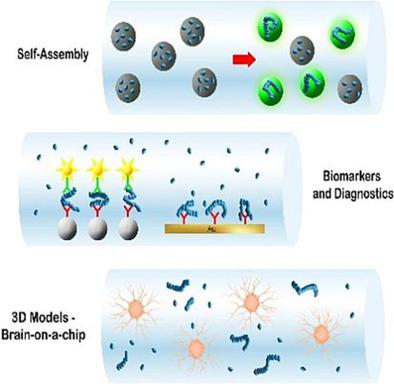当前位置:
X-MOL 学术
›
Chem. Asian J.
›
论文详情
Our official English website, www.x-mol.net, welcomes your
feedback! (Note: you will need to create a separate account there.)
Go with the Flow—Microfluidics Approaches for Amyloid Research
Chemistry - An Asian Journal ( IF 3.5 ) Pub Date : 2018-09-24 , DOI: 10.1002/asia.201801007 Shai Zilberzwige-Tal 1 , Ehud Gazit 1, 2
Chemistry - An Asian Journal ( IF 3.5 ) Pub Date : 2018-09-24 , DOI: 10.1002/asia.201801007 Shai Zilberzwige-Tal 1 , Ehud Gazit 1, 2
Affiliation

|
The rapid development of cost‐efficient microfluidic devices has received tremendous attention from scientists of diverse fields. The growing potential of utilizing microfluidic platforms has further advanced the ability to integrate existing technology into microfluidic devices. Thus, allowing scientists to approach questions in fundamental fields, such as amyloid research, using new and otherwise unachievable conditions. Amyloids are associated with neurodegeneration and are in the forefront of many research efforts worldwide. The newly emerged microfluidic technology can serve as a novel research tool providing a platform for developing new methods in this field. In this review, we summarize the recent progress in amyloid research using microfluidic approaches. These approaches are driven from various fields, including physical chemistry, electrochemistry, biochemistry, and cell biology. Moreover, the new insights into novel microfluidic approaches for amyloid research reviewed here can be easily modified for other research interests.
中文翻译:

顺应潮流—淀粉样蛋白研究的微流控方法
具有成本效益的微流体装置的快速发展受到了各个领域科学家的极大关注。利用微流体平台的增长潜力进一步提高了将现有技术集成到微流体设备中的能力。因此,允许科学家使用新的和否则无法实现的条件来解决诸如淀粉样蛋白研究等基本领域的问题。淀粉样蛋白与神经退行性疾病有关,并且在全世界许多研究工作中处于最前沿。新出现的微流体技术可以作为一种新颖的研究工具,为开发该领域的新方法提供平台。在这篇综述中,我们总结了使用微流体方法进行淀粉样蛋白研究的最新进展。这些方法来自各个领域,包括物理化学,电化学,生物化学和细胞生物学。此外,本文综述的淀粉样蛋白研究的新型微流控方法的新见解可以很容易地针对其他研究兴趣进行修改。
更新日期:2018-09-24
中文翻译:

顺应潮流—淀粉样蛋白研究的微流控方法
具有成本效益的微流体装置的快速发展受到了各个领域科学家的极大关注。利用微流体平台的增长潜力进一步提高了将现有技术集成到微流体设备中的能力。因此,允许科学家使用新的和否则无法实现的条件来解决诸如淀粉样蛋白研究等基本领域的问题。淀粉样蛋白与神经退行性疾病有关,并且在全世界许多研究工作中处于最前沿。新出现的微流体技术可以作为一种新颖的研究工具,为开发该领域的新方法提供平台。在这篇综述中,我们总结了使用微流体方法进行淀粉样蛋白研究的最新进展。这些方法来自各个领域,包括物理化学,电化学,生物化学和细胞生物学。此外,本文综述的淀粉样蛋白研究的新型微流控方法的新见解可以很容易地针对其他研究兴趣进行修改。











































 京公网安备 11010802027423号
京公网安备 11010802027423号